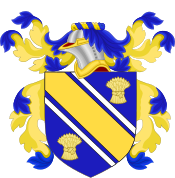Contents
Thomas Tillotson (c. 1751/1752 – May 5, 1832) was an American physician and politician.
Life
Born in the Province of Maryland around 1751 or 1752,[1][2] Tillotson received a thorough education, studied medicine, and practiced.[3] He was the great great nephew of the Archbishop of Canterbury John Tillotson. In 1776, he was commissioned as a First lieutenant in the Maryland Militia, and served during the American Revolutionary War.[3] He was appointed by Congress as a physician and surgeon general of the Northern Department of the Continental Army in 1780, and served until the close of the war.[3] Afterward, he settled in Rhinebeck, New York and engaged in the practice of medicine.[3]
In 1779, he married Margaret Livingston (1749–1823, sister of Chancellor Robert R. Livingston).[3] Their children included Robert, John, and Janette.[4] Janette was the wife of Judge James Lynch.[5]
A Federalist, he represented Dutchess County in the New York State Assembly in 1788.[3] In 1790, State Senator Anthony Hoffman died, and Tillotson was elected to fill the vacancy. He was a member of the State Senate from 1791 to 1799,[3] and served as a member of the Council of Appointment in 1791.[6]
He was elected as a Democratic-Republican to the 7th United States Congress in 1800, but resigned on August 10, 1801, before Congress met, to become Secretary of State of New York.[7] He remained in this office until March 15, 1806, and again from February 16, 1807, to February 1, 1808.[3]
He died in Rhinebeck on May 5, 1832, was buried in the Livingston family vault in the cemetery at the Dutch Reformed Church in Rhinebeck.[8]
Linwood

Tillotson's estate in Rhinebeck was known as "Linwood". It was originally part of the Artsen-Kip Patent. Tillotson purchased from Isaac Van Etten the southerly lot forming part of the lands which had been granted in 1688 by Governor Dongan to Gerrit Aertsen and others. It was bounded on the south and west by the Hudson River and on the east by the stream known as Landsmans Kill, which also formed the westerly boundary of the Beekman patent. On this property Dr. Tillotson in the years 1788-1790 laid out a country place and called it "Linwood." His house commanded a magnificent view of the river.[9]
He then acquired 150 acres of the Beekman land lying between Landsmans Kill and Fallsburgh Creek. This plateau, between the two streams, with extensive views of the Catskill mountains and Hudson river, became known as Linwood Hill. At the mouth of Landsmans Kill he built a dock and mill, where grain was ground. Dr. Tillotson also obtained at this time another part of the Beekman lands, twenty-nine acres of woodland lying east of Fallsburgh Creek, where two beautiful waterfalls bring it to the river level. This portion of the property became known as "Glenburn".[9]
In 1830, Tillotson gave "Glenburn" to his granddaughter, Julia Lynch, who later married Rev. Stephen Olin, President of Wesleyan University. After Tillotson's death, "Lindon Hill" was sold to Federal Vanderburgh.[9]
References
- ^ Year Book of the Dutchess County Historical Society, Volumes 13-22
- ^ Year Book of the Dutchess County Historical Society, Volumes 56-62
- ^ a b c d e f g h Year Book of the Dutchess County Historical Society, p. 35.
- ^ "Pension Application for Thomas Tillotson".
- ^ Colonial Families of Philadelphia, p. 1051.
- ^ The Papers of Alexander Hamilton, p. 247.
- ^ The Papers of Thomas Jefferson, p. 289.
- ^ "Patriots of the American Revolution Interred in the Rhinebeck Reformed Church Cemetery", p. 4.
- ^ a b c Historical and Genealogical Record Dutchess and Putnam Counties New York, Press of the A. V. Haight Co., Poughkeepsie, New York, 1912
 This article incorporates text from this source, which is in the public domain.
This article incorporates text from this source, which is in the public domain.
Sources
Books
- Year Book of the Dutchess County Historical Society. Vol. 13. Poughkeepsie, NY: Dutchess County Historical Society. 1928.
- Hamilton, Alexander (1965). The Papers of Alexander Hamilton. Vol. 9. New York, NY: Columbia University Press. ISBN 9780231089074.
- Jefferson, Thomas (2008). The Papers of Thomas Jefferson. Vol. 35. Princeton, NJ: Princeton University Press. ISBN 978-0-691-13773-5.
- Jordan, John W. (1911). Colonial Families of Philadelphia. Vol. II. New York, NY: Lewis Publishing Company. ISBN 9785880233557.
Internet
- "Pension Application for Thomas Tillotson" (PDF). revwarny.com. St. Johnsville, NY: Revolutionary War in NY State. Retrieved July 13, 2018.
- Hermans, Sarah K. (May 1, 2005). "Patriots of the American Revolution Interred in the Rhinebeck Reformed Church Cemetery" (PDF). NorthernDutchessDAR.org. Chancellor Livingston Chapter, National Society of Daughters of the American Revolution.
External links
- The Papers of Robert Morris, 1781-1784: April 16-July 20, 1782, by Robert Morris
- Rhinebeck, by Michael Frazier
- Thomas Tillotson at Find a Grave

